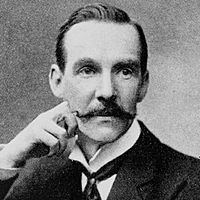E. W. Hobson facts for kids
Quick facts for kids
E. W. Hobson
|
|
|---|---|

Ernest William Hobson (1856–1933)
|
|
| Born | 27 October 1856 Derby, England
|
| Died | April 19, 1933 (aged 76) |
| Nationality | British |
| Alma mater | Royal School of Mines Christ's College, Cambridge |
| Known for | Real analysis |
| Awards | Royal Medal (1907) De Morgan Medal (1920) |
| Scientific career | |
| Fields | Mathematician |
| Institutions | Christ's College, Cambridge |
| Notable students | Philippa Fawcett John Maynard Keynes |
Ernest William Hobson (born October 27, 1856 – died April 19, 1933) was an English mathematician. He is mostly remembered for his important books on mathematical topics. These books helped introduce new ideas in mathematical analysis to English readers. He was a top professor of pure mathematics at the University of Cambridge from 1910 to 1931.
Contents
Life of a Mathematician
Ernest William Hobson was born in Derby, England. He went to Derby School, the Royal School of Mines, and Christ's College, Cambridge. In 1878, he graduated as a "Senior Wrangler." This means he was the top math student in his year at Cambridge.
Soon after graduating, he became a Fellow (a senior member) of Christ's College. He slowly became a research mathematician. He became an expert in the theory of spherical harmonics. These are special mathematical functions used to describe shapes like spheres.
Important Work in Real Analysis
His 1907 book on real analysis was very important for British mathematics. Real analysis is a branch of math that studies real numbers and functions. This book included new ideas about general topology (the study of shapes and spaces) and Fourier series (a way to break down complex waves into simpler ones). Even though some small mistakes were found later, the book was still highly praised.
From 1924 to 1927, another mathematician named Robert Pollock Gillespie studied with him.
Family and Burial
Ernest William Hobson was the brother of the famous economist John A. Hobson. He is buried in the Ascension Parish Burial Ground, Cambridge in Cambridge. His wife, Seline, and one of their four sons, Walter William, are buried with him.
Books and Publications
Ernest William Hobson wrote several important books on mathematics. Here are some of his well-known works:
- A Treatise on Trigonometry (1891)
- Theory of Functions of a Real Variable (1907)
- The third edition of Volume I was published in 1927.
- Mathematics, from the points of view of the Mathematician and of the Physicist (1912)
- Squaring the Circle (1913)
- John Napier and the Invention of Logarithms, 1614 (1914)
- The Domain of Natural Science (1923)
- The Theory of Spherical and Ellipsoidal Harmonics (1931)
See also
- Tonelli–Hobson test
- Symmetry of second derivatives
- Squaring the circle

